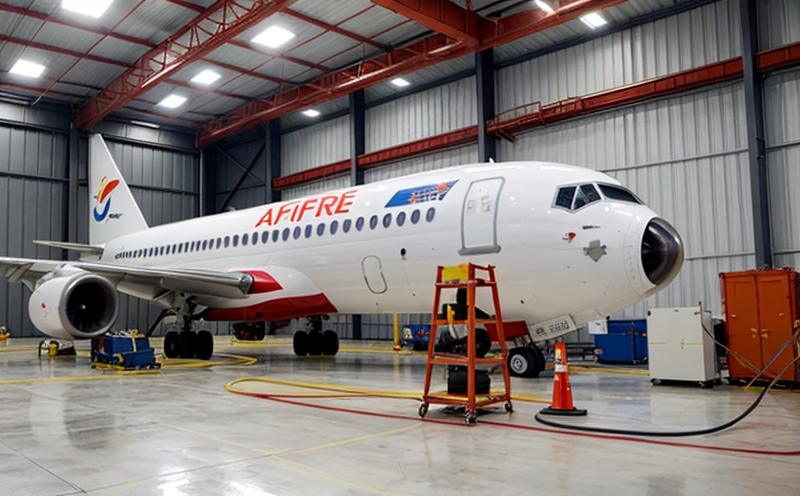Reaction-to-Fire Testing of Composite Aircraft Components
The reaction-to-fire (RTF) testing of composite aircraft components is a critical aspect of aerospace quality assurance. This testing ensures that materials used in the construction of aircraft are capable of resisting ignition and self-extinguishing when exposed to flame, thereby minimizing the risk of fire during operation.
Composite materials such as carbon fiber-reinforced polymer (CFRP) have become increasingly popular due to their lightweight properties. However, these materials can be prone to smoldering if not properly designed or tested for RTF performance. This is why rigorous RTF testing protocols are essential in aerospace applications.
The International Organization for Standardization (ISO), ASTM, and the European Committee for Standardization (CEN) all provide standards that govern RTF testing of composite materials used in aircraft components. For instance, ISO 16952:2017 outlines methods for determining the flammability characteristics of plastics and other thermoplastics, which can be relevant when assessing composites.
During RTF testing, samples are subjected to controlled flame exposure under specific conditions that mimic real-world scenarios. The test apparatus typically includes a furnace or a combustion chamber where specimens are exposed to heat and flame for varying durations depending on the standard being followed. Key parameters measured include peak heat release rate (PHRR), mass loss, smoke production, and oxygen index.
Specimen preparation is critical in ensuring accurate results from RTF tests. Specimens must be cut into standardized dimensions according to the relevant standard. Surface finish plays a significant role; any roughness or imperfections could affect test outcomes. After cutting, specimens are conditioned at specified environmental conditions to equilibrate moisture content.
The instrumentation used in RTF testing includes specialized combustion chambers equipped with calorimetric sensors capable of measuring heat release rates and optical smoke detectors. These instruments provide real-time data on how materials respond under fire exposure. The collected data is analyzed using statistical methods to determine compliance with specified limits for PHRR, mass loss, and other key metrics.
The importance of RTF testing cannot be overstated in the aerospace industry. Non-compliance can lead to catastrophic failures during flight operations, putting both passengers and crew at risk. By adhering strictly to international standards like ISO 16952:2017 and ASTM D635 test methods for thermoplastics, manufacturers ensure their products meet stringent safety requirements.
Understanding the nuances of RTF testing is crucial not only for compliance but also for continuous improvement in material selection and design optimization. Aerospace companies rely on rigorous testing to maintain high standards of product quality and safety across all stages of development from initial concept through final assembly.
Customer Impact and Satisfaction
Aerospace manufacturers who partner with us for Reaction-to-Fire Testing benefit greatly in several ways:
- Enhanced Safety Standards: By ensuring compliance with international standards, our testing helps reduce the risk of accidents caused by fire-related incidents.
- Market Competitiveness: Meeting stringent RTF requirements enhances a company's reputation and market position.
- Cost Efficiency: Early identification of material deficiencies through thorough testing can save substantial costs down the line by avoiding costly redesigns or recalls.
We consistently strive to exceed customer expectations by delivering accurate, reliable results within agreed timelines. Our team of experts works closely with clients throughout the process to ensure that all aspects of RTF testing are meticulously addressed. This collaborative approach fosters long-term relationships built on trust and mutual success.
International Acceptance and Recognition
- Aerospace Industry Standards: ISO 16952:2017, which specifies procedures for determining the flammability characteristics of plastics and other thermoplastics.
- ASTM D635 Test Methods: These are widely recognized for evaluating the burning behavior of thermoplastic materials under controlled conditions similar to those experienced in aircraft environments.
The acceptance of these tests extends beyond national boundaries, making them universally applicable across different regions and countries involved in aerospace manufacturing. Compliance with such standards demonstrates a manufacturer's commitment to international best practices which is increasingly important as global regulations converge towards harmonization.
Environmental and Sustainability Contributions
- Eco-Friendly Materials: By focusing on the sustainability of materials used in aircraft components, we contribute positively to reducing environmental impact.
- Energy Efficiency: Lightweight composites can help improve fuel efficiency, thereby lowering greenhouse gas emissions during flight operations.
The use of advanced composite materials like carbon fiber-reinforced polymers not only enhances structural integrity but also supports broader sustainability goals within the aerospace sector. Our RTF testing services play a pivotal role in promoting responsible material selection that balances performance with environmental considerations.





